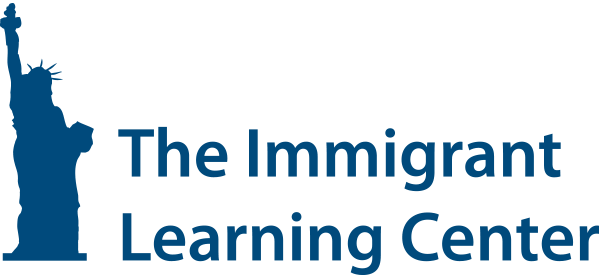People from Latin America have contributed deeply to the United States since its founding. From activists to performers to entrepreneurs to astronauts, exceptional foreign-born Latinx Americans have played vital and often overlooked roles in the history of the U.S. The Immigrant Learning Center has created this list of famous Latinx immigrants to share a small piece of that history. After learning more about these nine people, we encourage you to continue to explore this important legacy.
A note on terminology:
The meaning of the terms “Latino/Latina,” “Hispanic” and “Latinx” have evolved and been debated over time. Demographers and sociologists have defined and redefined these terms based on racial background, language, ethnicity and/or national origin. For the purposes of this blog post, we use the commonly accepted definition of “Latinx” and “Latino/Latina” as immigrants or descendants of immigrants from Spanish-speaking Caribbean, South American and Central American countries. To learn more about the history and usage of these terms, the Pew Research article Who is Hispanic goes into greater detail.
Arturo Alfonso Schomburg, Historian / Activist, 1874 – 1938
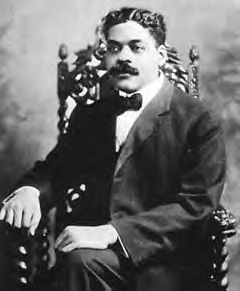
Source: By Unknown author – “Figuras Historicas De Puerto Rico, Vol. 2” ; Image dated 1910 and Courtesy of the “Puerto Rican Institute of Culture” which is a government institution., Public Domain, https://commons.wikimedia.org/w/index.php?curid=1968661
When Arturo Alfonso Schomburg was a child, his schoolteacher told him that Black people had “no history, heroes or accomplishments.” Schomburg spent the rest of his life proving that teacher wrong. Born in Puerto Rico, before it became a United States colony, to a Black mother and white father, Schomburg studied “Negro literature” at St. Thomas College in the Danish Virgin Islands. He moved to New York City by himself when he was 17. Working under the principle that “The American Negro must remake his past in order to make his future,” he embarked on an extraordinary career of civil rights activism and Afro-Latinx historical research, including the creation of the Negro Society for Historical Research in 1911.
Schomburg made it his personal mission to collect and preserve the writings of Black and Afro-Latinx historical figures. In the process, he became a part of that history himself as a key figure in the Harlem Renaissance. He wrote articles for prominent Black publications, and his collection of historical writings grew to contain more than 10,000 items. His personal collection, which included correspondence by Haitian revolutionary Toussaint L’Ouverture, poems by enslaved poet Phyllis Wheatley, letters written by Frederick Douglas, the journals of abolitionist Paul Cuffe and much more, was eventually purchased by the New York Public Library (NYPL) for $10,000. The purchase led to the formation of the NYPL’s Schomburg Center for Research in Black Culture, which is an active and thriving research library to this day.
Gabriela Mistral, Poet / Diplomat, 1889 – 1957
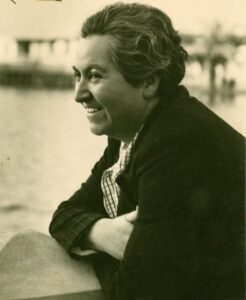
Source: Biblioteca Nacional de Chile, CC0, via Wikimedia Commons
Chilean American Gabriela Mistral turned childhood hardship and early heartbreak into gorgeous poetry, becoming the first Latin American and the fifth woman to receive the Nobel Prize in Literature. Mistral wrote on universal themes of loss, faith and love, making her a beloved icon in Chile. Despite this, she always had a conflicted relationship with her country of origin, opting to join the country’s diplomatic service in 1926 and spend her life traveling. She eventually settled in the United States with her longtime companion Doris Dana, where she continued to write poems and political essays with a feminist and international perspective.
Mistral’s often melancholy poetry and apparently lonely life created a public image of the poet as a tragic and solitary figure. Chile’s autocratic Pinochet regime held her up as an ideal Chilean woman, “a symbol of social order and submission to authority.” This perception was transformed when her personal letters were published, revealing a passionate side to the poet and her relationship with Dana. The pair were romantically involved for almost 10 years before Mistral’s death. This revelation has led to reinterpretations of her writing and elevated her status as an early queer writer.
Oscar de la Renta, Fashion Designer, 1932 – 2014

Source: Matti Hillig, CC BY-SA 3.0 <https://creativecommons.org/licenses/by-sa/3.0>, via Wikimedia Commons
What do Jacqueline Kennedy, Taylor Swift and Oprah Winfrey have in common? All have worn clothing designed by iconic Dominican American designer Oscar de la Renta. De la Renta’s family encouraged him to pursue his artistic passions from a young age, funding a trip to Spain to study art from the Royal Academy of San Fernando. When the fashion sketches he did for pocket money proved popular, he switched his focus to the world of fashion.
De la Renta moved to the U.S. and rose quickly through the ranks. He made his name at Arden, a fashion brand founded by Canadian American entrepreneur Elizabeth Arden, then moved on to run the popular Derby fashion line while still in his early 30s, and eventually joined Balmain, making him the first Dominican designer at a French fashion house. By the time he was 40, fashion enthusiasts were referring to him as the “Grandfather of Fashion.” De la Renta’s brand was known for elegant and romantic looks, an aesthetic he connected to his Latin American background. Over the course of his career, he dressed five First Ladies and countless stars like Nicole Kidman and Cindy Crawford.
He was quick to turn his professional success into philanthropic ventures. The orphanage he founded in the Dominican Republic still serves hundreds of children yearly. He also extensively supported arts organizations in the United States. His work has been recognized with two Coty awards, known as the “Oscars of fashion,” a Carnegie Hall Medal of Excellence, and a series of stamps issued by the U.S. Postal Service that celebrated his designs. Though he passed away from cancer in 2014, his influence on the world of fashion lives on to this day.
Franklin Chang-Diaz, Astronaut / Entrepreneur, 1950 –
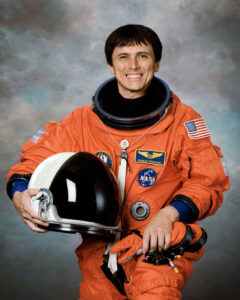
Source: NASA, Public domain, via Wikimedia Commons
As the child of a poor Costa Rican-Chinese family, Franklin Chang-Diaz looked up at the stars and knew he wanted to join his hero Buzz Aldrin among them. His path to becoming the first Latinx immigrant and first naturalized citizen astronaut at NASA wasn’t smooth, though. He knew he needed to go the U.S. to achieve his dream, which required staying with extended family in Connecticut to complete high school, learning English very quickly, wrangling scholarships to attend college and successfully competing for an elite PhD program in applied plasma physics at MIT.
In 1980, Chang-Diaz’s hard work came to fruition when NASA selected him to train as an astronaut. Over the next 25 years, he flew seven missions on the Space Shuttle, which included almost 20 hours of spacewalks, and ran the Advanced Space Propulsion Laboratory at the Johnson Space Center from 1993 to 2005. Not content to rest on his already extraordinary achievements, Chang-Diaz founded Ad Astra Rocket Company after retiring from NASA. The company is a leader in the field of plasma rocket propulsion technology and has partnered with NASA to advance space exploration. In recognition of his incredible work, his childhood hero Buzz Aldrin personally presented him with the “Buzz Aldrin Quadrennial Space Award” in 2014.
Gloria Estefan, Singer / Songwriter / Entrepreneur / Actor, 1957 –

Source: Gloriaestefan_ahoy.jpg: Ron van Ruttenderivative work: Work permit, CC BY-SA 3.0 <http://creativecommons.org/licenses/by-sa/3.0/>, via Wikimedia Commons
As a teen in Cuba, Gloria Estefan used music as her only escape from the stress of caring for her ill father and younger siblings. Hours spent practicing alone in her room paid off after her family fled to Miami in the aftermath of the Cuban Revolution. She joined the band Miami Sound Machine, drawn to the group by the keyboardist, Emilio Estefan, whom she later married. The band enjoyed success in Spanish-speaking countries before recording some breakthrough English-language hits that expanded their appeal and brought them fame in the United States.
In 1990, her career was almost ended by a touring bus accident that left her with a broken back. Despite warnings that she might never walk again, she returned to touring within a year and performed at the Super Bowl halftime show a year after that. Estefan’s tenacity led to a remarkably successful and long career. She has achieved 38 number one hits on Billboard charts, a Kennedy Center Honor, three Grammy and a star on the Hollywood Walk of Fame.
Outside of music, Estefan has also been successful in philanthropy and business. The Gloria Estefan Foundation supports spinal cord research to help people like Estefan who experience serious spinal injuries, as well as funding no-kill animal shelters, homeless shelters, and Latino cultural organizations. Gloria and Emilio Estefan’s business empire, Estefan Entreprises, includes music production and a chain of Cuban-themed restaurants. In 1993 she received an Ellis Island Medal of Honor, which recognizes exceptional naturalized U.S. citizens, and in 2015 she was awarded a Presidential Medal of Freedom.
Jorge Ramos, Journalist, 1958 –
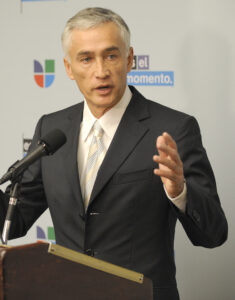
Source: Bill Ingalls, NASA, Public domain, via Wikimedia Commons
Jorge Ramos, the “Walter Cronkite of Latin American television,” first came to the U.S. after an editor in Mexico quashed a story that Ramos had written because it was critical of the Mexican government. He has taken full advantage of the freedom of the press that he found here. Since 1987, Ramos has co-hosted Noticiero Univision, the most popular Spanish-language newscast in the United States. Over the course of his nearly 40-year career in broadcast journalism, he has developed a reputation for hard-hitting, trustworthy reporting. Ramos has covered five wars, interviewed every U.S. president since President Bush Sr. excepting President Trump, and won 10 Emmys along the way. Ramos also produced the documentary Hate Rising in 2016 in response to the expansion of hate groups in the United States.
His long and influential career has led to Ramos being consistently ranked as one of the most influential Hispanics in the United States, alongside Supreme Court Justice Sonia Sotomayer. Univision is ranked with the Catholic Church among the most trusted institutions in Latino communities. In 2015, he was named on Time’s list of “The World’s 100 Most Influential People.” Ramos’ success is credited for paving the way for countless other Latin American journalists in the United States.
Luis von Ahn, Entrepreneur, 1979 –

Source: EneasMx, CC BY-SA 4.0 <https://creativecommons.org/licenses/by-sa/4.0>, via Wikimedia Commons
If you have solved a CAPTCHA or learned some new vocabulary from Duolingo recently, you probably have Guatemalan American entrepreneur Luis von Ahn to thank. A childhood gift of a computer sparked von Ahn’s interest in coding and computer science, but his passion for productivity and education has shaped his career. After studying cryptography, he co-created CAPTCHAs, anti-spam filters that distinguish between humans and bots. When Von Ahn discovered that people were collectively spending 500,000 hours per day solving CAPTCHAs, he created reCAPTCHAs to put that time to use. ReCAPTCHAs test users by asking them to transcribe snippets of difficult to decipher text from actual documents supplied by Google Books, The New York Times, and other organizations that have archives in need of digitization. The arrangement has made countless previously inaccessible documents available to the public.
His passion for making knowledge more accessible is clear in his current venture, Duolingo. The program is one of the most popular language-learning tools available. Duolingo offers free lessons in more than 40 languages, engaging more than half a billion users around the world. Von Ahn says he’s motivated to make language learning available to everyone, explaining, “From my upbringing in Guatemala I’ve seen that education is the key to opportunity and equality, but I’ve always felt it’s unfair that the best education is often only available to those with money.”
Jordi Muñoz, Entrepreneur, 1986 –
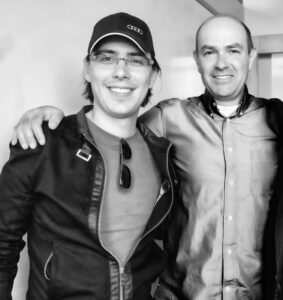
Jordi Munoz, left, with his co-founder Chris Anderson Source: By Christopher Michel, CC BY 2.0 <https://creativecommons.org/licenses/by/2.0>, via Flick
When Jordi Muñoz first moved to the U.S. from Mexico, he wasn’t permitted to work or continue his university studies while he waited for his green card, but he wasn’t prevented from learning. He decided at age 20 to obtain what he calls a “Google PhD” in aeronautics and computer science. Drawing on information available for free online and the shared wisdom of fellow drone enthusiasts, he managed to build a homemade drone using a modified Nintendo Wii console as its controller. His work caught the attention of Chris Anderson, one of his fellow drone enthusiasts with more resources, and the pair co-founded 3D Robotics.
The startup expanded rapidly, and today it’s the largest drone company in North America and the second largest in the world. His company has created more than 200 jobs and brings in more than $5 million in revenue, but Muñoz hasn’t abandoned his collaborative roots. All of the company’s software is open source, a model that encourages crowdsourced, cooperative improvement of the software. Muñoz has also found creative uses for his drones, including discreetly tracking the migration paths of animals and inspecting archeological sites without damaging them. The same drive that led him to build a drone in his garage has had positive effects on countless fields. In an interview, Muñoz also credits the encouragement he received in the United States for his success, saying, “It really is a land of opportunities. So it doesn’t matter what is your background. If you work hard and do the right thing, and you’re honest, you can always do what you want in the U.S.”
Raffi Freedman-Gurspan, Activist, 1987 –
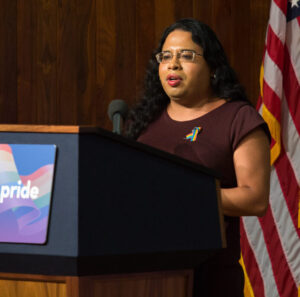
Source: US Department of Labor, CC BY 2.0 <https://creativecommons.org/licenses/by/2.0>, via Wikimedia Commons
As a transgender, Jewish, indigenous, adoptee from Honduras, Raffi Freedman-Gurspan is used to being “the first” at whatever she does. She was the first openly transgender staffer in the Massachusetts State House and the first transgender appointee in the White House. Freedman-Gurspan has not sought the spotlight. Instead she has quietly dedicated herself to activism and political work on behalf of all marginalized people.
She began her career in local politics, working first as the LGBT liaison for the mayor of Somerville, Massachusetts, then as the legislative director for a state representative, where she helped pass one of the first transgender civil rights bills. Freedman-Gurspan spent a year as a policy analyst for the National Center for Transgender Equality (NCTE) before being tapped by President Obama’s administration to become the White House’s LGBT liaison. She helped the White House to respond to both national tragedies like the Pulse nightclub shooting and incredible triumphs like the legalization of marriage equality. After leaving with the outgoing administration, she returned to the NCTE, saying, “I realized we got to defend all the things that we just accomplished.” When asked about her motivation for her extensive public service, she cites the influence of her parents, both of whom worked as social workers, and the Reform Judaism tradition that she was raised in. In an interview, Freedman-Gurspan explained, “There’s so much suffering in the world, and if I can help alleviate that, I feel like, as we say in Hebrew, I’ve done a mitzvah.”
These influential figures are just a few of the countless Latinx immigrants who have shaped the United States. Our Immigrant Entrepreneur Hall of Fame features more Latinx founders who have created jobs in the U.S., including Marcelo Claure of Brightstar Corp., and William and Rafael Cruz of TradeStation Group Inc. Our immigrant entrepreneur video interview series includes many interviews with Latinx immigrants, including co-founder of CERO Coop Josefina Luna and co-founder of Guardian Healthcare Jose de la Rosa, as does our JobMakers podcast.
